What’s all the buzz? Well, we are buzzing about Honeybees!
It’s common for little ones to be afraid that bees might sting, but honeybees are the friendliest of bees. They also make delicious honey and are wonderful pollinators! That means they help plants grow. Honeybees are responsible for 80% of crop pollination in the United States, and a very small proportion of the wild plant pollination. Learn why honeybees are important and how we need them for the environment.
 Did you know humans have relied on bees for thousands of years? Unfortunately, millions of bees are dying every day. There are three main reasons for the bees’ extinction, and they are parasites, habitat loss, and cell phones.
Did you know humans have relied on bees for thousands of years? Unfortunately, millions of bees are dying every day. There are three main reasons for the bees’ extinction, and they are parasites, habitat loss, and cell phones.
A recent study suggests that as many as 40% of the world’s insect species are in decline. Insects are facing extinction rates that are eight times higher than vertebrates. In Germany, scientists have recorded losses of up to 75% of the total mass of insects in protected areas.
What can we do to save the bees? Let’s start by leaning about them. This content explains the development, habitat, and lifecycle of Honeybees.
For example, according to Merriam-Webster’s Dictionary, “honeybee” and “housefly” and “bedbug” are spelled as one word.
STAGE OF DEVELOPMENT
All honeybees are social and cooperative insects. A Honeybee Colony typically consists of three kinds of adult bees, Workers, Drones, and a Queen. The descriptions below discuss information regarding the three types of bees.
Workers
Workers forage for food (pollen and nectar from flowers), build and protect the hive, clean, circulate air by beating their wings, and perform many other societal functions.
The Queen
The queen’s job is simple laying the eggs that will spawn the hive’s next generation of bees. There is usually only a single queen in a hive. If the queen dies, workers will create a new queen by feeding one of the female larvae an exclusive diet of a food called “royal jelly.” This elixir enables the worker to develop into a fertile queen. Queens also regulate the hive’s activities by producing chemicals that guide the behavior of the other bees.
Drones
Male bees are called drones—the third class of honeybee. Several hundred drones live in each hive during the spring and summer, but they are expelled for the winter months when the hive goes into a lean survival mode.

The development of a drone from egg to adult takes about 24 days. Whereas queen and worker development are quicker.
| Average time taken for an egg to develop into an adult bee | |
| Worker | 18 – 22 days |
| Queen | 16 days |
| Drone | 24 days |


Species may include:
- Univoltine – raising one brood of bees in a year, and therefore with one flight period.
- Bivoltine – raising two broods of bees in a year, and therefore having two flight periods.
- Facultatively bivoltine – some bee species may have one or two broods, usually depending on environmental factors.
- Cleptoparasitic bee species such as nomad bee species lay their eggs in the nests of target host species.
- The emerging adult females therefore do not construct a nest of their own. Another example are the cuckoo bumble bees.

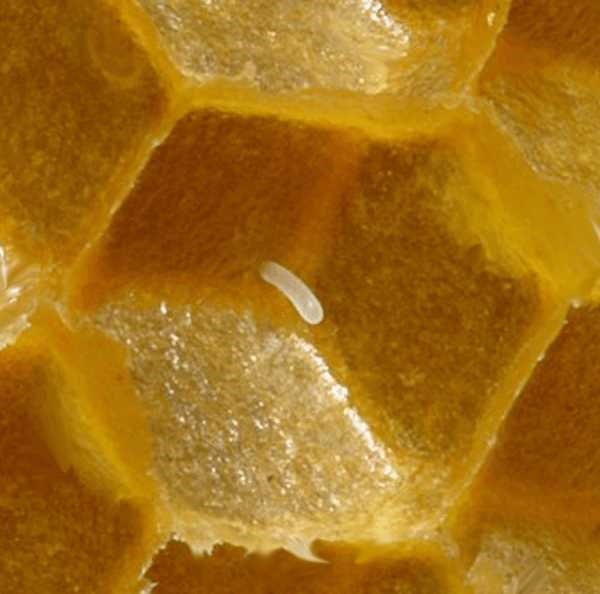
The first stage: The Egg
An egg is laid by a queen or female in a specially prepared cell. The structure and materials used to make the cell may differ depending on species. For example, honeybee and bumble bee eggs cells are constructed from wax. This image shows the egg of honeybee inside a wax cell

The second stage: Larva
In Solitary Bee species, each individual egg is provided with a food supply then sealed. Honeybee and bumble bee larvae are fed by adults as they develop in the cell. The egg hatches into a larva. The larvae lack eyes and legs, and typically look like a small, curled up grubs, one in each cell.
Bees are holometabolous, and as such, they have true grub-like larvae rather than nymphs. The larvae look completely different from the adult which emerges later. The larva feeds on food stores provided by the queen, egg laying female or workers, depending on species.
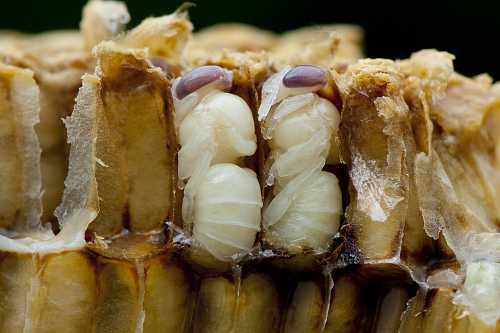
The third stage: Pupa
The larva is fed until it forms a prepupa. At this point, some features are clearly formed, such as eyes, legs, head, thorax, abdomen. Some solitary bee species, spin a cocoon and may overwinter inside it. The prepupa then becomes a pupa.
This image shows the Pupa Stage of the Honeybee
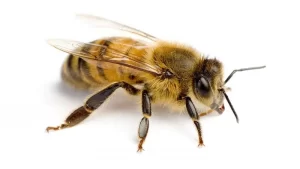
The fourth stage: Adult
From pupa, new adults emerge. In solitary species, usually the males emerge first, but in bumble bees and honeybees, the first to emerge are female workers followed by males (Drone Honeybees).
This Image shows an adult Drone Honeybee.
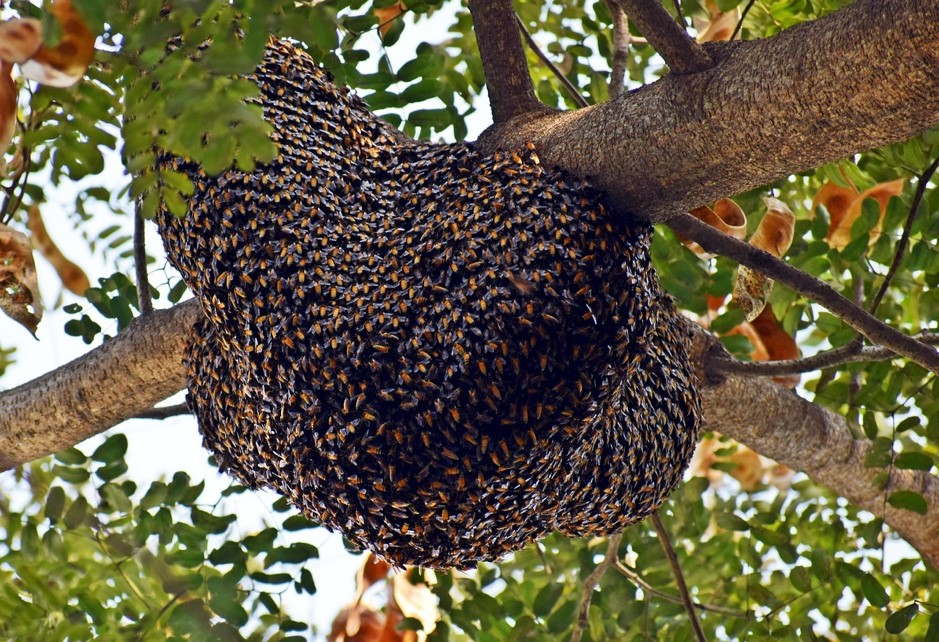
Beehives
A beehive is an enclosed structure in which some honeybee species of the subgenus Apislive and raise their young. Though the word beehive is commonly used to describe the nest of any bee colony, scientific and professional literature distinguishes nest from hive. Nest is used to discuss colonies that house themselves in natural or artificial cavities or are hanging and exposed. Hive is used to describe an artificial/man-made structure to house a honeybee nest. Several species of Apis live in colonies, but for honey production the western honeybee (Apis mellifera) and the eastern honeybee (Apis cerana) are the main species kept in hives.
The nest’s internal structure is a densely packed group of hexagonal prismatic cells made of beeswax, called a honeycomb. The bees use the cells to store food (honey and pollen) and to house the brood (eggs, larvae, and pupae).
Beehives serve several purposes: production of honey, pollination of nearby crops, housing supply bees for apitherapy treatment, and to try to mitigate the effects of colony collapse disorder. In America, hives are commonly transported so that bees can pollinate crops in other areas. Several patents have been issued for beehive designs.
From Wikipedia, the free encyclopedia
A natural beehive is like a bird’s nest, designed for the protection of the colony. Often these colonies are established in tree hollows or cavities in rock outcroppings.
Bees typically make their hives in straw, pottery, or wood. The structure is a densely packed group of hexagon shaped cells made of honeycomb and propolis. They then use propolis to fill crevices and seal parts of the honeycomb.
What is Propolis & How Do Honeybees Use It?
(Propolis is a substance collected by bees from tree buds.)
Honeybees gather an amazing compound called propolis, better known as “bee glue”, from the sap of trees and buds. This sticky, brownish resin collected by the bees is used to seal cracks and drafts, repair their hive and possibly even to polish brood cells between brood cycles. During this time of year, honeybees are working hard preparing their homes and protecting themselves for the long winter months ahead, and propolis is that glue that holds it all together and provides the best defense for their immunity.
Propolis also has many benefits being used for a heath aid!
Research suggests that propolis has several properties that could benefit human health. People can use it on the skin, as a mouthwash, and as a supplement for a variety of minor health concerns. Ancient Egyptians used propolis for embalming, and some doctors used it during World War II to help with wound healing.
As a rough guideline, propolis typically consists of:
- tree and vegetable resins: 50%
- beeswax: 30%
- pollen: 5%
- essential and aromatic oils: 10%
- Propolis also contains polyphenols, such as flavonoids, which are a type of antioxidant
- Antibacterial
- Antifungal
- Antiviral
- antiprotozoal, which means that it works against parasitic illnesses, such as giardiasis
- anti-inflammatory
- Although people have used propolis for many health conditions in the past, there is not strong scientific evidence to support all of them.
How do honeybees make hives?
Bees live on stored honey and pollen all winter, and cluster into a ball to conserve warmth. Larvae are fed from the stores during this season, and, by spring, the hive is swarming with a new generation of bees.
Worker honeybees make hives to store honey and feed themselves throughout winter when they cannot go outdoors to forage for food. Honeybee hives are made of six-sided tubes, which are the shapes for optimal honey production because they require less wax and can hold more honey. Some hives develop broods which become dark in color over time because of cocoon tracks and travel stains. Other honeybee hives remain light in color.
Wild honeybees make hives in rock crevices, hollow trees and other areas that scout bees believe are appropriate for their colony. Similar to the habits of domesticated honeybees, they construct hives by chewing wax until it becomes soft, then bonding large quantities of wax into the cells of a honeycomb. When worker bees crowd together within a hive, the hive remains at around 30 to 35 degrees Celsius, the temperature necessary to control the texture of the wax.
Although worker bees only live for approximately six weeks, they spend their lives performing tasks that benefit the survival of their colony. Around the time a worker bee turns 10 days old, she develops a unique wax-producing gland inside her abdomen. Workers forage for food and gather nectar from different flowering plants. When they carry nectar within their pollen pouch, it mixes with a specialized enzyme.
After returning to the hive, the worker bee transfers the nectar from her tongue to another worker’s tongue, where the liquid from the nectar evaporates and becomes honey.
The glands of worker bees convert the sugar contents of honey into wax, which oozes through the bee’s small pores to produce tiny flakes of wax on their abdomens. Workers chew these pieces of wax until they become soft and moldable, and then add the chewed wax to the honeycomb construction.
The hexagonal cells of the honeycomb are used to house larvae and other brood, as well as to store honey, nectar and pollen. When beekeepers extract honey from hives, the comb is easily left intact, though beekeepers sell honeycomb as well.

Did you know that a honeybee hive usually has between 20,000 and 80,000 bees living together in a colony?
Bee species and their habitat
In the hive, bees have designated roles – queen, drone, or worker bee. The female worker bees do everything else to keep the hive humming along – they feed larvae, produce honeycomb, collect nectar and pollen, keep the hive clean, ventilate the hive by vibrating their wings, and of cores they make honey.
Hollow Trees
Feral or wild Apis mellifera honeybees are eusocial, meaning they live in large, well-organized colonies employing a strict division of labor regarding building and maintaining hives and caring for offspring. Commonly building their hives in hollow trees, they are cavity dwellers, a characteristic that makes the species easily domesticated. In the wild, they will seek out an enclosed space with a capacity of 15 to 100 liters in which to build their hive. Once the bees have selected a suitable tree with a hollow trunk high enough off the ground to deter honey hunters and with a south-facing, downward-pointing entrance, they set to work preparing their new hive. The bees strip off outer layers of bark to smooth the walls, then seal and coat them with propolis or “bee glue” made from tree and plant resins in preparation for building wax honeycombs.
Underground Hives
Bumblebees, of the genus Bombus, prefer to locate their natural beehives underground, usually in abandoned animal burrows and tunnels. After emerging from hibernation in the spring the queen bumblebee will select a hive site, as bumblebees only use a nest for one year. She will line the hole in the ground with dry grass and moss in preparation for the first brood of worker bees. The workers will sometimes build a wax canopy over the hive entrance to deter their predators, mainly skunks.
Aerial Hives
Aerial, or open-air, hives are constructed by southeastern Asian honey \bees belonging to the genera Micrapis and Megapis. These permanent natural hives are like the temporary swarm nests of the Apis mellifera honeybees. The Asian bees construct honey and brooder combs attached to exposed tree limbs or cliff faces. They coat the immediate surrounding area with waxy propolis to prepare it for comb construction. The parallel, evenly spaced, rows of combs are covered by the bodies of the bee colony members for protection from the elements and predators. During rainstorms the bees on the outer layer extend their wings over the swarm to keep the inner combs dry.
There are thousands of different types of bees found around the world. While most bee species tend to make nests in the ground, there are several that build nests in trees. These nests can be found in both dead and living trees. The possibility of having bee nests in trees depends on the types of bees that live in your environment, the types of trees in your area and the availability of other nest material.
Wild Honeybees
Wild honeybees, with the scientific name of Apis mellifera, will build nests in hollowed out areas of trees. They will not burrow through trees but will only make nests in already existing cavities. The honeycombs that are made in beehives are also made in the trees. The bees will use this nest for many years as the workers and queens can survive in the nest over the winter.
Bumble Bees
Bumble bees, the Bombus species, will nest in trees if a tree has an existing cavity or an empty bird’s nest is in a tree. Traditionally they will nest in the ground, but they can sometimes be found in trees. Their tree nests, however, will not be found very high as the bees like to be close to their food source, namely flowers. These are not aggressive bees and will only sting if the nest is in danger.
Stingless Bees
Several species of stingless bee’s nest in trees, though these nests are typically found in tropical areas. Two types of bees within the Trigona species create their nests in living trees, and nests can contain up to 10,000 adult bees. Bees will not nest in all types of trees. Not all stingless bees will nest in trees and the Lisotrigona carpenteri bees only make small nests in walls found in man-made structures.
Carpenter Bees
Carpenter bees will create nests in dead trees. They will burrow into the dead timber and soft trees. They cannot burrow through dead hardwood trees. Two types of carpenter bees that have are known to build nests in dead trees include the green carpenter bee and the yellow and black carpenter bees: both in the Xylocopa species. Some species of carpenter bees have become endangered as land clearing and timber industries have removed the habitats for these bees.
Types of Natural Beehives
Approximately 20,000 different species of bees exist worldwide, occupying every habitat that contains flowering plants. Bees live in a symbiotic relationship with flowers, having evolved a long tongue or proboscis for lapping up nectar. Many bees are social insects, living and working together in highly organized colonies or communities. They live in various kinds of natural habitations called hives or nests.

The original source of this last natural, wild honeycomb we couldn’t track down, however it’s amazing structure, size and complexity was too intense for us to overlook!
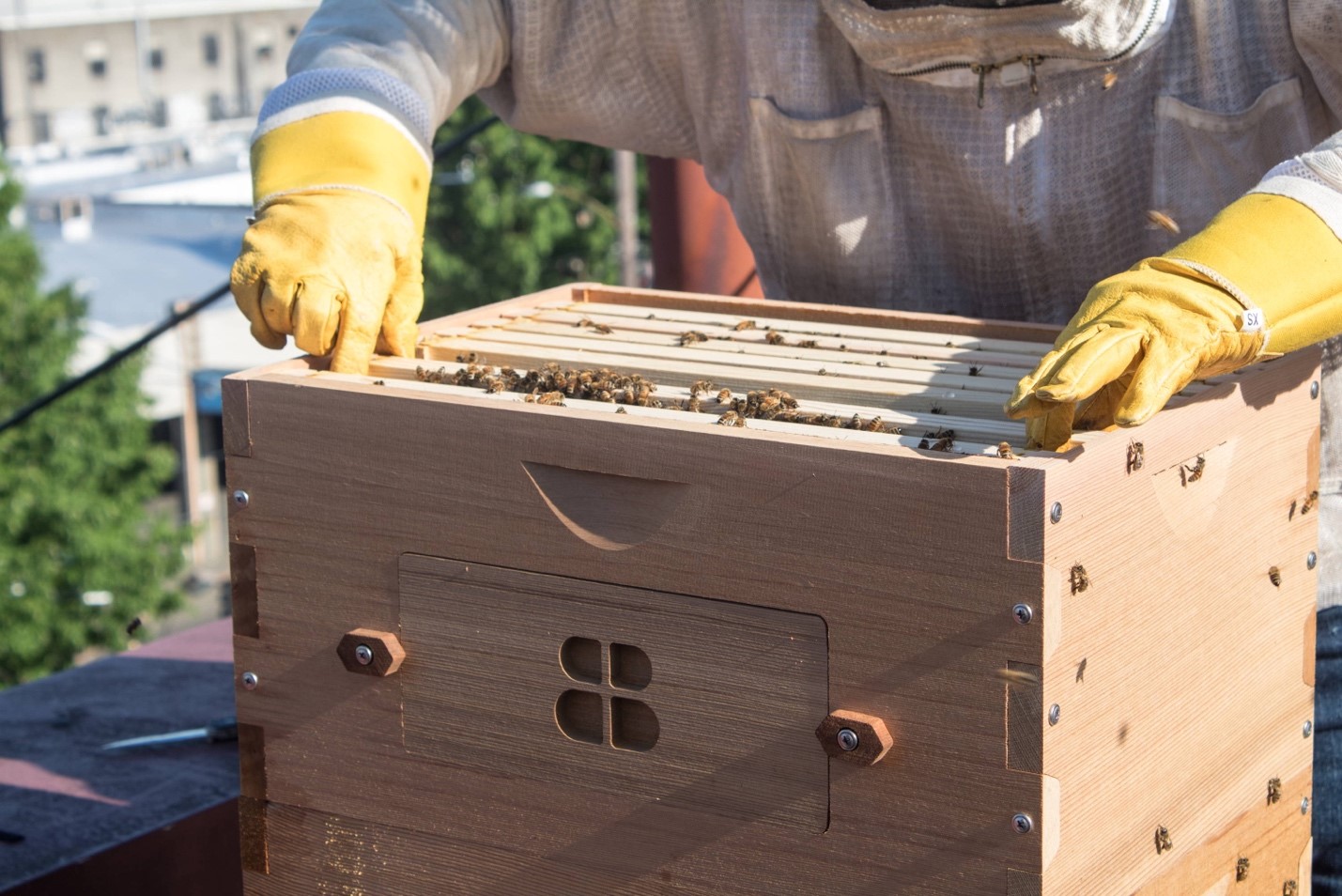
What is the role of a beekeeper? You might hear the term being thrown around all the time, but just what is beekeeping, and what does it entail?
They provide bees with hives for shelter, medications and, as needed. Beekeepers also organize, control, coordinate and operate apiaries to produce honey, queen bee pollen, beeswax and royal jelly, breed queen bees and pollinate crops.
Natural beekeeping is a holistic, hands-off approach. Instead of “farming bees” or “managing hives,” natural beekeepers are guardians of their bees. If you want to be a natural beekeeper, you host bees in your yard, and periodically check on them, adding space to the hive to meet their needs.
There are three main types of beehives in use today – the Langstroth, the Warre and the Top Bar.
Each of these has its advantages and disadvantages.
Visit the following link to read about the three types of natural beekeeping:
https://www.perfectbee.com/your-beehive/beehives-and-accessories/common-types-of-beehive
Over time, beekeeping has evolved. The way beekeeping is done today differs in many aspects from how beekeeping was done in its infancy stages. Beekeeping in modern times is largely practiced using beehives. Some of the beehives mimic tree hollows or the early log hives that beekeeper used.
In years past, and for a very long period of time, beekeeping was done by farmers with large tracts of land, or by placing beehives in forests. Follow the provided link to learn about the history of beekeeping:
https://beekeepclub.com/getting-started-beekeeping/what-is-beekeeping-the-beginners-introduction/
Creative Activity: Make a beehive – Art & Crafts
Building a beehive is a great activity that students can do with easy-to-use materials. Let your homeschoolers make their own Beehive. Provided below are videos and descriptions on how to build different beehives. Your student can be as creative as they want!
https://supersimple.com/article/create-your-own-beehive/
Additional Items you may need:

- Bubble wrap
- Paint – yellow and orange
- Construction paper – brown, blue, yellow, and green
- Yellow pom poms
- Black pipe cleaner
- Scissors
- Craft glue
- Glue stick
- Paintbrush – we used a sponge paintbrush
- Crayon or marker
- Small piece of white paper
- Googly eyes
Parent/Teacher – Have your student reflect on what they learned.
- Have your student write an essay on the development and life cycle of Honeybees. Your student can use the free printable lined paper, located on the sidebar of the student account – optional.
Support@Discoveryk12.com
